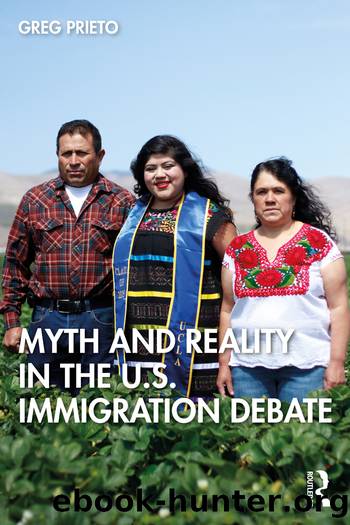Myth and Reality in the U.S. Immigration Debate by Greg Prieto

Author:Greg Prieto [Prieto, Greg]
Language: eng
Format: epub
ISBN: 9781138656314
Barnesnoble:
Publisher: Taylor & Francis
Published: 2020-09-18T00:00:00+00:00
Discussion Questions
In the immigration debate, some commentators make the commonsensical claim that if we invite more immigrants into the labor pool, wages have to go down: a simple rule of supply and demand. If more workers are added to the labor supply, consequently demand for workers goes down, and wages fall. Based on the evidence presented in this chapter, how might you respond to such a claim? Consider the key concepts introduced in this section, including the lump of labor fallacy, the segmented labor market, substitutability and complementarity, and the metaphor of the economy as a balloon (not a pie) as you formulate your response.
Why do immigrants commit less crime than the U.S.-born in the first generation? How does the immigrant revitalization perspective help us understand this seemingly counterintuitive finding? Why does criminal activity among the second generation catch up to the U.S.-born? What role do assimilation and legal cynicism play in this process? For those who come from or have lived in immigrant-rich communities, have you seen evidence of the immigrant revitalization or the legal cynicism perspectives in your own neighborhoods?
Why is it important to measure fiscal impacts over the entire life cycle? Which methodâstatic or dynamic analysesâdoes this better? Recall the difference between marginal vs. average cost approaches to incorporating public goods into the costs that immigrants impose on budgets, why is this difference so important? Which approach do you prefer?
A latent argument in this chapter is that immigrantsâ impact on wages, crime, and budgets, whether positive or negative, is likely quite small. When we zoom out from the immigration issue specifically and consider the range of factors that influence wages, crime, and budgets, what stands out? Why does it seem to be harder and harder to find work that secures a middle class living? What forces beyond immigration might explain why this economy seems more unforgiving than in the past? Is the United States becoming more crime ridden over time or less? Why? And what other social forces influence taxes and spending at the local, state, and federal levels? When we place immigration alongside these other factors, to what extent would more immigration enforcement and exclusion address the pressing issues of our time?
Do the insights presented in this chapter typically make it into the mainstream debate? Why or why not? What is the proper place of empirical evidence in a debate as consequential as the immigration debate?
Download
This site does not store any files on its server. We only index and link to content provided by other sites. Please contact the content providers to delete copyright contents if any and email us, we'll remove relevant links or contents immediately.
Cecilia; Or, Memoirs of an Heiress — Volume 1 by Fanny Burney(32497)
Cecilia; Or, Memoirs of an Heiress — Volume 2 by Fanny Burney(31910)
Cecilia; Or, Memoirs of an Heiress — Volume 3 by Fanny Burney(31894)
The Great Music City by Andrea Baker(31758)
We're Going to Need More Wine by Gabrielle Union(19003)
All the Missing Girls by Megan Miranda(15779)
Pimp by Iceberg Slim(14435)
Bombshells: Glamour Girls of a Lifetime by Sullivan Steve(14022)
For the Love of Europe by Rick Steves(13598)
Talking to Strangers by Malcolm Gladwell(13292)
Norse Mythology by Gaiman Neil(13280)
Fifty Shades Freed by E L James(13187)
Mindhunter: Inside the FBI's Elite Serial Crime Unit by John E. Douglas & Mark Olshaker(9265)
Crazy Rich Asians by Kevin Kwan(9223)
The Lost Art of Listening by Michael P. Nichols(7454)
Enlightenment Now: The Case for Reason, Science, Humanism, and Progress by Steven Pinker(7274)
The Four Agreements by Don Miguel Ruiz(6702)
Bad Blood by John Carreyrou(6583)
Weapons of Math Destruction by Cathy O'Neil(6218)
